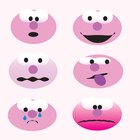
Most people like to believe their personality and character are valued over physical attractiveness, but in reality, beautiful men and women are typically more sought-after and admired than those who are merely average-looking. Additionally, as clinical psychiatrist Dale Archer points out in "The Psychology of Beauty," published on Psychology Today, beautiful women might become so used to admiration that they expect compliments. If a beautiful girl is in your life or you're trying to attract one, prepare yourself by learning various innovative ways to describe her beauty and get her attention.
What Is Beauty?
Deciding exactly what makes a girl beautiful can help you focus your description. Think about each specific physical feature, such as her eyes, hair or smile. Ask yourself if any details in particular draw your attention and stick in your memory. Think about what makes each characteristic so appealing. Perhaps her eyes are an unusual color, such as a deep shade of violet blue, or her smile is engaging because it seems so joyful and sincere. Don't forget to include some characteristics of her inner beauty such as kindness or her ability to enjoy simple pleasures; no one wants to be admired for their looks alone.
How Beauty Affects the Viewer
Don't forget to include the impact her beauty has on you. If you find her beauty so overwhelming and distracting that you can't concentrate on anything else, let her know that's how she affects you. If you can't stop thinking about her or picturing her in your mind when you're apart, include that detail in your description. On Psychology Today, clinical psychologist Leon F. Selzer says in, "The Hidden Role of Flattery and Baby Talk in Romantic Love," that praising the one you admire helps inflame passion. An honest and heartfelt expression of how her beauty makes you feel enriches your description.
Using Figurative Language
Poetic comparisons enhance descriptions of a beautiful girl. Consider similes that use the words, "like" or "as" to highlight the girl's qualities in the comparison. For example, "Her black hair shimmered like a lake in moonlight," instantly conveys the mental image of ripples. Metaphors that describe the comparison without using "like" or "as" also convey an image, such as: "Her eyes were pools of bejeweled water." Hyperbole or exaggeration is also often used to describe beauty as in the line, "Your beauty takes my breath away."
Famous Descriptions of Beauty
Throughout the centuries, poets have used figurative language to describe beautiful women. Shakespeare's sonnets provide examples of how to use such literary devices. When Romeo first sees Juliet in the well-known play, "Romeo and Juliet," he describes her beauty using metaphor, simile and hyperbole, "Oh, she doth teach the torches to burn bright! It seems she hangs upon the cheek of night, Like a rich jewel in an Ethiope’s ear ... I ne'er saw true beauty till this night." You might not be a Shakespeare, but you can learn to describe beautiful girls using poetic language.
Related Articles

What Are 5 Amazing Compliments to Give ...

How to Tell a Girl She's Beautiful ...

What Do I Do if My Girlfriend Thinks ...

The Sweetest Birthday Presents for ...

How to Flirt With a Girl While Chatting

How to Show Affection

What Color Clothes Makes Brown Eyes ...

How to Go for a Kiss With a Shy Woman

Benefits of Soybean Oil for Hair

Should Women Over 60 Wear Eyeliner?

What is Hair Composed of?

How to Word a Welcome Home

Difference Between Flattery & ...

Signs a Teenage Girl Likes You

What Would Go with a Black & Blue Skirt?

How to Make Myself Feel Beautiful After ...

Valentine Alliteration Ideas

How to Attract the Artsy Type Woman

Good Ways to Start a Card for ...

How to Know If Your Girlfriend Is Still ...
References
Resources
Writer Bio
Freddie Silver started writing newsletters for the Toronto District School Board in 1997. Her areas of expertise include staff management and professional development. She holds a master's degree in psychology from the University of Toronto and is currently pursuing her PhD at the Ontario Institute for Studies in Education, focusing on emotions and professional relationships.
Photo Credits
AntonioGuillem/iStock/Getty Images